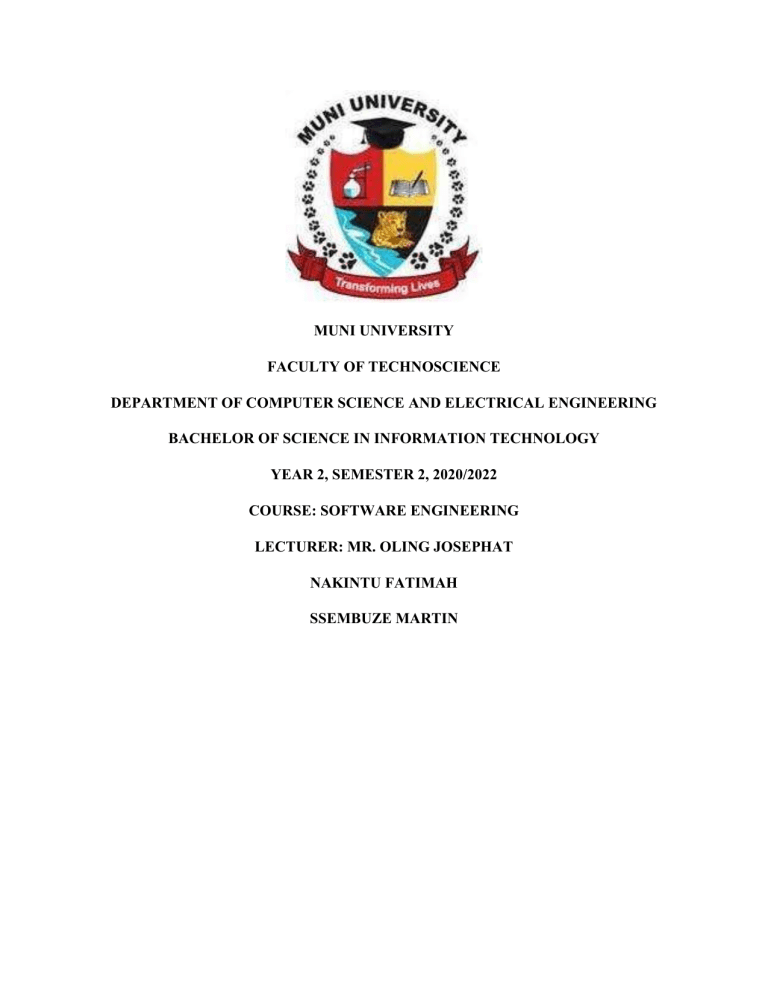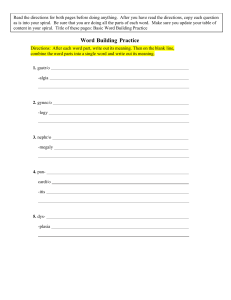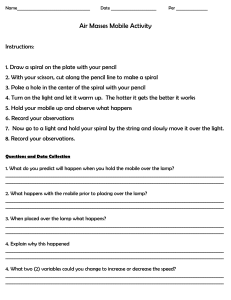
MUNI UNIVERSITY FACULTY OF TECHNOSCIENCE DEPARTMENT OF COMPUTER SCIENCE AND ELECTRICAL ENGINEERING BACHELOR OF SCIENCE IN INFORMATION TECHNOLOGY YEAR 2, SEMESTER 2, 2020/2022 COURSE: SOFTWARE ENGINEERING LECTURER: MR. OLING JOSEPHAT NAKINTU FATIMAH SSEMBUZE MARTIN Software Process software process (software methodology) is a set of associated activities that leads to the production of the software. These activities may comprise of the development of the software from the scratch, or, adjusting an existing system. Any software process must include the following four activities: Software specification (requirements engineering): Define the main functionalities of the software and the constraints around them. Software design and implementation: The software is to be designed and programmed. Software verification and validation: The software must conform to its specification and meet the customer's needs. Software evolution (software maintenance): The software is being modified to meet customer and market requirements changes. Spiral Model According to The spiral model is risk-driven where the process is denoted as a spiral rather than a sequence of activities. The spiral model is similar to the incremental model, with more emphasis placed on risk analysis. The spiral model has four phases: Planning, Risk Analysis, Engineering and Evaluation. Planning Phase: Requirements are collected during the planning phase. Requirements like ‘BRS’ that is ‘Business Requirement Specifications’ and ‘SRS’ that is ‘System Requirement specifications. Risk Analysis: In the risk analysis phase, a process is assumed to identify risk and alternate solutions. A prototype is produced at the end of the risk analysis phase. If any risk is found during the risk analysis, then alternate solutions are proposed and implemented. Engineering Phase: In this phase software is developed, along with testing at the end of the phase. Hence in this phase the development and testing are done. Evaluation phase: This phase allows the customer to evaluate the output of the project to date before the project continues to the next spiral. Advantages of Spiral model: High amount of risk analysis hence, avoidance of Risk is enhanced. Good for large and mission-critical projects. Strong approval and documentation control. Additional Functionality can be added at a later date. Software is produced early in the software life cycle. Disadvantages of Spiral model: Can be a costly model to use. Risk analysis requires highly specific expertise. Project’s success is highly dependent on the risk analysis phase. Doesn’t work well for smaller projects. When to use Spiral model: When costs and risk evaluation is important For medium to high-risk projects Long-term project commitment unwise because of potential changes to economic priorities Users are unsure of their needs Requirements are complex New product line REFERENCES: 1.Software Engineering — Software Process and Software Process Models (Part 2) | by Omar Elgabry | OmarElgabry's Blog | Medium https://medium.com/omarelgabrys-blog/software-engineering-software-process-and-softwareprocess-models-part-2-4a9d06213fdc Accessed: 2022-09-30 2.https://www.shikhadeep.com.np/2021/03/describe-spiral-model-with-its.html 3.http://tryqa.com/what-is-spiral-model-advantages-disadvantages-and-when-to-use-it



